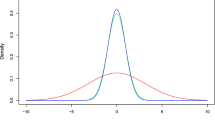Abstract
This paper investigates the use of stratified sampling as a variance reduction technique for approximating integrals over large dimensional spaces. The accuracy of this method critically depends on the choice of the space partition, the strata, which should be ideally fitted to the subsets where the functions to integrate is nearly constant, and on the allocation of the number of samples within each strata. When the dimension is large and the function to integrate is complex, finding such partitions and allocating the sample is a highly non-trivial problem. In this work, we investigate a novel method to improve the efficiency of the estimator “on the fly”, by jointly sampling and adapting the strata which are hyperrectangles and the allocation within the strata. The accuracy of estimators when this method is used is examined in detail, in the so-called asymptotic regime (i.e. when both the number of samples and the number of strata are large). It turns out that the limiting variance depends on the directions defining the hyperrectangles but not on the precise abscissa of their boundaries along these directions, which gives a mathematical justification to the common choice of equiprobable strata. So, only the directions are adaptively modified by our algorithm. We illustrate the use of the method for the computation of the price of path-dependent options in models with both constant and stochastic volatility. The use of this adaptive technique yields variance reduction by factors sometimes larger than 1000 compared to classical Monte Carlo estimators.
Similar content being viewed by others
References
Alfonsi, A. (2009, to appear). High order discretization scheme for the CIR process: application to affine term structure and Heston model. Mathematics of Computation.
Arouna, B. (2004). Adaptative Monte Carlo method, a variance reduction technique. Monte Carlo Methods and Applications, 10(1), 1–24.
Asmussen, S., & Glynn, P. W. (2007). Stochastic modelling and applied probability: Vol. 57. Stochastic simulation: algorithms and analysis. New York: Springer.
Dudley, R. M. (2002). Cambridge studies in advanced mathematics: Vol. 74. Real analysis and probability. Cambridge: Cambridge University Press. Revised reprint of the 1989 original.
Etore, P., & Jourdain, B. (2009). Adaptive optimal allocation in stratified sampling methods. Methodology and Computing in Applied Probability, 9(2), 117–152.
Etore, P., Fort, G., Jourdain, B., & Moulines, E. (2008). On adaptive stratification (Technical Report). arXiv:0809.1135 math.PR.
Glasserman, P. (2004). Stochastic modelling and applied probability: Vol. 53. Monte Carlo methods in financial engineering. New York: Springer.
Glasserman, P., Heidelberger, P., & Shahabuddin, P. (1999). Asymptotically optimal importance sampling and stratification for pricing path-dependent options. Mathematical Finance, 9(2), 117–152.
Judistsky, A., Lan, G., Nemirovski, A., & Shapiro, A. (2007). Stochastic approximation approach to stochastic programming (Technical Report). http://www2.isye.gatech.edu/~nemirovs/.
Kawai, R. (2007). Adaptive Monte Carlo variance reduction with two-time-scale stochastic approximation. Monte Carlo Methods and Applications, 13(3), 197–217.
Kushner, H. J., & Yin, G. (2003). Stochastic modelling and applied probability: Vol. 35. Stochastic approximation and recursive algorithms and applications (2nd ed.). New York: Springer.
Owen, A. B. (1992). A central limit theorem for Latin hypercube sampling. Journal of the Royal Statistical Society, Series B, 54(2), 541–551.
Owen, A. (2003). Quasi Monte Carlo sampling. In Monte Carlo ray tracing: Siggraph 2003 course.
Pflug, G. Ch. (1996). The Kluwer international series in engineering and computer science: Vol. 373. Optimization of stochastic models. The interface between simulation and optimization. Dordrecht: Kluwer Academic.
Rubinstein, R. Y., & Kroese, D. P. (2004). Information science and statistics. The cross-entropy method. A unified approach to combinatorial optimization, Monte-Carlo simulation, and machine learning. New York: Springer.
Rubinstein, R. Y., & Kroese, D. P. (2008). Wiley series in probability and statistics. Simulation and the Monte Carlo method (2nd ed.). New York: Wiley.
Author information
Authors and Affiliations
Corresponding author
Rights and permissions
About this article
Cite this article
Etore, P., Fort, G., Jourdain, B. et al. On adaptive stratification. Ann Oper Res 189, 127–154 (2011). https://doi.org/10.1007/s10479-009-0638-9
Published:
Issue Date:
DOI: https://doi.org/10.1007/s10479-009-0638-9




